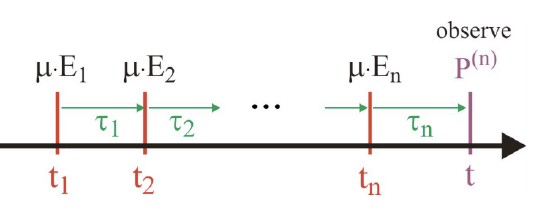1.4: Summary - General Expressions for nth Order Nonlinearity
- Page ID
- 302010
For an nth-order nonlinear signal, there are n interactions with the incident electric field or fields that give rise to the radiated signal. Counting the radiated signal there are n+1 fields involved (n+1 light-matter interactions), so that nth order spectroscopy is at times referred to as (n+1)- wave mixing. The radiated nonlinear signal field is proportional to the nonlinear polarization:
\[P^{(n)}(t)=\int_0^{\infty}d\tau_n\dotsi\int_0^{\infty}d\tau_1R^{(n)}\left(\tau_1,\tau_2,\dotsc\tau_n\right)\bar E_1\left(t-\tau_n-\dotsb -\tau_1\right) \dotsm \bar E_n(t-\tau_n) \]
\[\begin{aligned}
R^{(n)}\left(\tau_{1}, \tau_{2}, \ldots \tau_{n}\right) &=\left(\frac{i}{\hbar}\right)^{n} \theta\left(\tau_{1}\right) \theta\left(\tau_{2}\right) \ldots \theta\left(\tau_{n}\right) \\
& \times \operatorname{Tr}\left\{\left[\left[\ldots\left[\mu_{I}\left(\tau_{n}+\tau_{n-1}+\ldots+\tau_{1}\right), \mu_{I}\left(\tau_{n-1}+\tau_{n}+\cdots \tau_{1}\right)\right], \ldots\right] \mu_{I}(0)\right] \rho_{e q}\right\}
\end{aligned} \label{2.4.2}\]
Here the interactions of the light and matter are expressed in terms of a sequence of consecutive time intervals \(\tau_1 \dotso \tau_n\) prior to observing 14 the system. For delta-function interactions, \(\bar E_i(t-t_0)=|\bar E_i|\delta(t-t_0)\), the polarization and response function are directly proportional
\[P^{(n)}(t)=R^{(n)}(\tau_1,\tau_2,\dotsc \tau_{n-1},t)|\bar E_1|\dotso|\bar E_n| \label{2.4.3}\]



